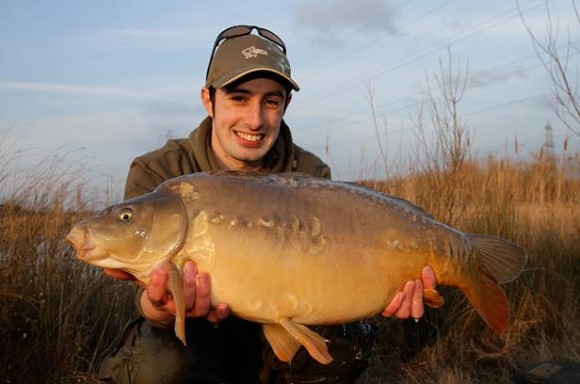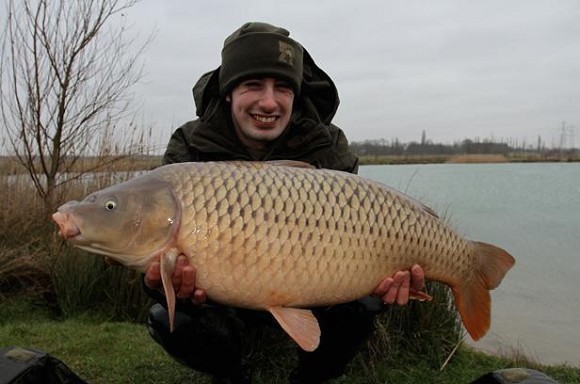
Are you missing out because you're using your ‘favourite' main line?
Are you missing out because you're using your ‘favourite' main line? Jed Kent thinks so and here's why...
The subject of lines has always been an interesting one to me. We all know that carp hate lines, so what can we do to help the situation? Well ask yourself this question: do you change your line to suit the water? Or do you stick with the same tried and tested one regardless of the venue? Over the years of mainly fishing my main line straight through, including as a hooklength, it doesn't take long to work out if the line is good for getting bites on or not.
This was really highlighted to me when fishing on a local day ticket lake with my dad. He done me 4-0 using the same bait and rig but he was using a different main line. The lake in question is a small, heavily stocked lake with shallow brownie/murky water. I found some fish in a bay really going for it; they were fizzing up like mad in the silty bottom. So I crept into the swim and cast my light leads at said fizzers. I then pulled off some line to fish it slack and more importantly to sink. For the next 20 or so minutes the carp kept on fizzing so I knew that I hadn't spooked them. Then slowly they just stop and melted away. I couldn't understand this, as when my dad done the same thing in a different swim he caught? I kept moving onto feeding fish but the end result would be the same. I even tied up some light Double Strength hooklengths just to try to get a bite. My dad was using a dark coloured 0.37 15lb line straight through so why didn't I get a bite? It was then after taking a beating and lots of banter that I come to the conclusion that my line was showing up on the silty lakebed. At the time I was fishing a 130-acre reservoir so I needed a line that suited that lake.
Example 2
Another instance when line choice was paramount was when I fished Sandhurst on the Yateley complex for four nights on my birthday a few years ago. Sandy is a heavily pressured day ticket lake that some very good anglers have fished, so I needed to get everything spot-on if I was to catch these crafty old carp. I did some research and after speaking to Nigel Sharp and browsing the forums, I came to the conclusion that the fishing was mostly done in the open water with hardly any snags around the lake. I decided that I would spool up with different lines, two spools were on a brown 0.26 8lb line and the other two with a dark coloured 0.33 line. This gave me options as to what lines to use as I had never been to the lake before, let alone fished it. The last thing I wanted was to get down there and not have what I needed as Sandy is a 360-mile round trip for me, so I could hardly nip back home.
To cut a long story short, I had an amazing trip, having 26 bites in total, landing five thirties up to 36lb 8oz and most of my takes had come to my 8lb straight through set-up. My best mate, Thomas, was next-door and he had 10 bites using the same line just in 12lb not 8lb but the rig and bait was the same. I never lost a fish that trip because of my line snapping as I was using soft rods and light leads. I had people casting at my zone as I was catching fish but they didn't catch as many as me. I remember Sharpy coming down to see me on this trip and whilst chatting about lines he mentioned that one year, in winter, on another water only anglers using a certain brand/colour of line caught fish in the day.
Fluoro stands out
I do love using a good sinking line, be it mono or fluorocarbon, but at times I'm sure the fluoro has cost me fish because it was held in off the bottom whilst fishing a clear weedy lake. I was speaking to the editor, Joe, about this and he said to me that from all the eye-opening underwater features the mag has done, they noticed that fluorocarbon stands out if it's not sunk tight to the lakebed. If it's held up in any weed or debris, light can pass through it, causing it to stand-out and also casting a shadow below it. This got me thinking and so on this particular lake I changed a few things to try getting a few more bites.
After blanking in style for a few trips, I decided to add a long length of tungsten tubing to help disguise my fluoro main line. It worked a treat resulting in two lovely originals. Next trip I did the same on the fluoro but on my other two rods I changed my main line to a good sinking mono without the tubing. Again, my plan worked with the mono producing the only two fish on the lake while I was there.
In summary
To some up, I would really think about the lake your fishing before choosing a line. Is the lake clear? Is it weedy? What does the lakebed consist of? Is the lakebed flat? Is it snaggy? On a flat bottom lake with hardly any features I would use a fluorocarbon main line together with a slack line. The chances are that most of the line will be along the bottom and not held up making it obvious to the carp. On snag-free lakes I would choose a light line with softer rods, as scaling down does gets you more bites; just look at what the match guys do. On a clear weedy lake use a strong mono line that is a greeny/brownie colour so it will blend in better, as your line is most likely to be held up off the bottom at some point.
This is a rough guide on my findings and I hope it helps you to choose the right line for the job and to put more fish on the bank for you. I'm not saying you can't just use one line for every lake but just have a think about it before you spool up. In carp fishing there can be such a fine line between failure and success so I hope my ramblings has given you some food for thought. Be lucky and bag a big 'un.
Jed Kent
Rob Hughes Final Thoughts...
"Main line should be a major consideration and it always pays to match your line to the colour of the water you are fishing in. Dark lines e.g. Fox Warrior are very good in clear water and low light conditions ad light lines e.g. Aquos or Soft Steel are better in clear water, bright conditions. If there is weed around or algae suspended in the water then go for a green line, but fish it slack and remember that when you look at your line you are looking down at it, but when fish look at it they can see it from above below and the sides depending on the depth of the water. It pays to match the colour of the line to the colour of the water, not just the colour of the bottom."







